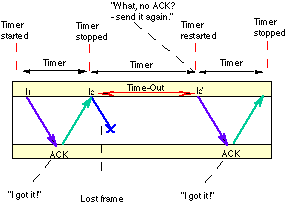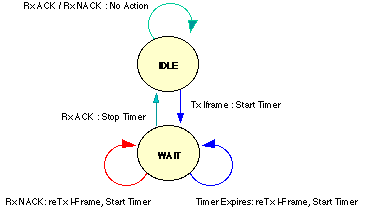
Stop and Wait transmission is the simplest reliability technique and is adequate for a very simple communications protocol. A stop and wait protocol transmits a Protocol Data Unit (PDU) of information and then waits for a response. The receiver receives each PDU and sends an Acknowledgement (ACK) PDU if a data PDU is received correctly, and a Negative Acknowledgement (NACK) PDU if the data was not received. In practice, the receiver may not be able to reliably identify whether a PDU has been received, and the transmitter will usually also need to implement a timer to recover from the condition where the receiver does not respond.
Under normal transmission the sender will receive an ACK for the data and then commence transmission of the next data block. For a long delay link, the sender may have to wait an appreciable time for this response. While it is waiting the sender is said to be in the "idle" state and is unable to send further data.

Stop and Wait ARQ - Waiting for Acknowledgment (ACK) from the remote node.
The blue arrows show the sequence of data PDUs being sent across the link from the sender (top to the receiver (bottom). A Stop and Wait protocol relies on two way transmission (full duplex or half duplex) to allow the receiver at the remote node to return PDUs acknowledging the successful transmission. The acknowledgements are shown in green in the diagram, and flow back to the original sender. A small processing delay may be introduced between reception of the last byte of a Data PDU and generation of the corresponding ACK.
When PDUs are lost, the receiver will not normally be able to identify the loss (most receivers will not receive anything, not even an indication that something has been corrupted). The transmitter must then rely upon a timer to detect the lack of a response.

Stop and Wait ARQ - Retransmission due to timer expiry
In the diagram, the second PDU of Data is corrupted during transmission. The receiver discards the corrupted data (by noting that it is followed by an invalid data checksum). The sender is unaware of this loss, but starts a timer after sending each PDU. Normally an ACK PDU is received before this the timer expires. In this case no ACK is received, and the timer counts down to zero and triggers retransmission of the same PDU by the sender. The sender always starts a timer following transmission, but in the second transmission receives an ACK PDU before the timer expires, finally indicating that the data has now been received by the remote node.
The state diagram (also showing the operation of NACK) is shown below:

State Diagram for a simple stop and wait protocol
(Green for ACK, Blue for Data, Red for NACK)
More Info (not included in EG3567 Course):